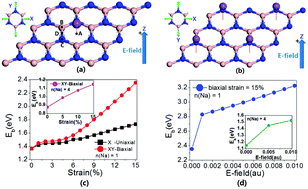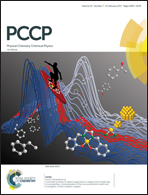Most effective way to improve the hydrogen storage abilities of Na-decorated BN sheets: applying external biaxial strain and an electric field
Abstract
Density functional calculations were used to investigate the hydrogen storage abilities of Na-atoms-decorated BN sheets under both external biaxial strain and a vertical electric field. The Na atom generally has the weakest binding strength to a given substrate compared with the other elements in the periodic table [PANS, 2016, 113, 3735]. Consequently, it is understudied in comparison to other elements and there are few reports about the hydrogen storage abilities of Na-decorated nanomaterials. We calculated that the average binding energy (Eb) of Na atoms to the pure BN sheet is 1.08 eV, which is smaller than the cohesive energy of bulk Na (1.11 eV). However, the Eb can be increased to 1.15 eV under 15% biaxial strain, and further up to 1.53 eV with the control of both 15% biaxial strain and a 5.14 V nm−1 electric field (E-field). Therefore, the application of biaxial strain and an external upward E-field can prevent clustering of the Na atoms on the surface of a BN sheet, which is crucial for the hydrogen storage. Each Na atom on the surface of a BN sheet can adsorb only one H2 molecule when no strain or E-field is applied; however, the absorption increases to five H2 molecules under 15% biaxial strain and six H2 molecules under both 15% biaxial strain combined with a 5.14 V nm−1E-field. The average adsorption energies for H2 of BN-(Na-mH2) (m = 1–6) are within the range of practical applications (0.2–0.6 eV). The hydrogen gravimetric density of the periodic BN-(Na-6H2)4 structure is 9 wt%, which exceeds the 5.5 wt% value that should be met by 2017 as specified by the US Department of Energy. On the other side, removal of the biaxial strain and E-field can help to desorb the H2 molecule. These findings suggest a new route to design hydrogen storage materials under near-ambient conditions.



 Please wait while we load your content...
Please wait while we load your content...